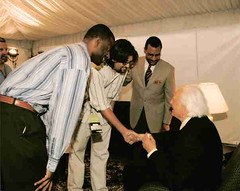An Intergenerational Stirring: Why Christian Churches Should Adopt Public Schools
“… In love, he predestined us to be adopted…” – Ephesians 1:4-5 (NIV)
Last month’s Pastors Prayer Summit made history. Not just because more pastors and ministry leaders attended the three-day retreat (293) than in any prior year, or because the 35 participating youth workers represented a 600-700% increase.
Most significantly, this fifteenth summit, sponsored annually by Concerts of Prayer Greater New York, was the first time in memory that so many local evangelical leaders prayed intentionally – with one voice and for more than a few minutes – for New York City’s two million young people. Rather than generic, “Bless them, Lord” prayers, they focused instead on specific concerns:
- At-risk youth within particular churches, including the incorrigible ones, the nondescript ones who blends into the background, and the weak ones whom bullies target;
- Personal and community struggles, such as sexuality, HIV/AIDS, family disintegration, and gangs;
- Systemic injustices such as a public education system where 60% of elementary school students don't read at grade level, yet we spend $12 billion educating them, and generational poverty that traps nearly 30% of NYC children below the poverty line, with 72% of Latino and 61% of African American children in poor families; and
- The commissioning of ministers, both church-based and marketplace workers such as teachers, paraprofessionals, business managers, health professionals, and students themselves, to love youth without judgment.
This intentionality extended into a break-out session where approximately 75-100 leaders conducted an “intergenerational conversation” around how to enagage the region’s youth and youth culture with the gospel more effectively. With the assigned room packed beyond capacity, the floor and hallway provided overflow space.
Why the zealous response? Consider that Jesus described children, who represent 25% of the city’s overall population, as the most ripe for a spiritual “harvest.” Who's more "like a child" – Christ's prerequisite for entering the kingdom of heaven – than a child? Moreover, having been an at-risk youth (the subject of a future column), city kids are especially dear to Jesus’ heart.
To make the conversation more manageable – engaging all of the city’s two million kids 18 and under (by themselves, the fifth largest city in America) is a daunting proposition – the discussion centered on the 1.1 million students in New York’s public schools (only the tenth largest city).
Why public schools? To borrow another of Jesus’ metaphors, effective “fishing” requires going where fish gather, namely (cheesy pun alert) within schools. Factor in the reality that public school students come disproportionately from our city’s most vulnerable communities and compassion compels Christ followers to be transformational agents in the mix.
How then should believers and churches engage within the context of a nonreligious public school system? For starters, by viewing the system not as an enemy with which to wage some misguided holy war, but as an ally for equipping kids to live the lives God has called for them.
Beyond that, the summit explored the idea of churches “adopting” particular schools within their neighborhoods. Adoption is hardly a novel idea. The Fund for Public Schools has launched a campaign for local businesses to adopt schools for a cash or in-kind contribution, event sponsorship, and volunteer hours. Their ubiquitous PSAs run daily on radio stations throughout the region.
Nationally, the Campus Alliance network of campus ministries urges churches to adopt schools through its http://www.everyschool.com/ website. While their agenda seems limited to evangelistic aims, rather than also including systemic reforms, their call to pray for schools, equip students to live faith on campus, encourage volunteerism, and value schools as allies is significant. A review of the EverySchool database suggests that churches and ministries have adopted just 33 city schools through this resource to date.
As a citywide strategy, the best part about adopting schools is it’s doable. Numerically, the 1.1 million students are spread across 1,200 public schools. By contrast, sociologist Tony Carnes of Columbia University has found 7,100 active evangelical, charismatic, and Pentecostal churches within the five boroughs. That’s nearly a 7:1 ratio of churches to schools. Including the 1,000 private and/or parochial schools, there are still more than three churches for every school.
Imagine if every congregation committed to pray regularly for at least one elementary, middle, or high school in the boroughs. Now imagine if individual congregants became answers to those prayers by volunteering within the schools as hallway monitors, classroom assistants, tutors, event organizers, PTA delegates, or coaches. Even better, imagine if the students themselves were empowered to be salt and light on the campuses; and if God-fearing staff members, whether teachers, aids, principals, or agency administrators, recognized their profession as a calling. Dare we expect that test scores might even improve and resources be managed better?
What might happen if the Body of Christ within those 7,100 churches actually functioned as such and incarnated Christ within the walls of our schools? Kids might actually be loved unconditionally, families served selflessly, and schools transformed in ways we all long to see.
Rather than wage a quixotic battle to reinstate a meaningless nondenominational thirty-second prayer in schools, why not resolve collectively to actually pray; repent of neglecting to labor where the fields are white unto harvest; and commit to loving our schools through adoption?
- Jeremy Del Rio, Esq. serves public school students through Generation Xcel. To adopt a city school, visit www.GenXcel.blogspot.com.













0 Comments:
Post a Comment
<< Home